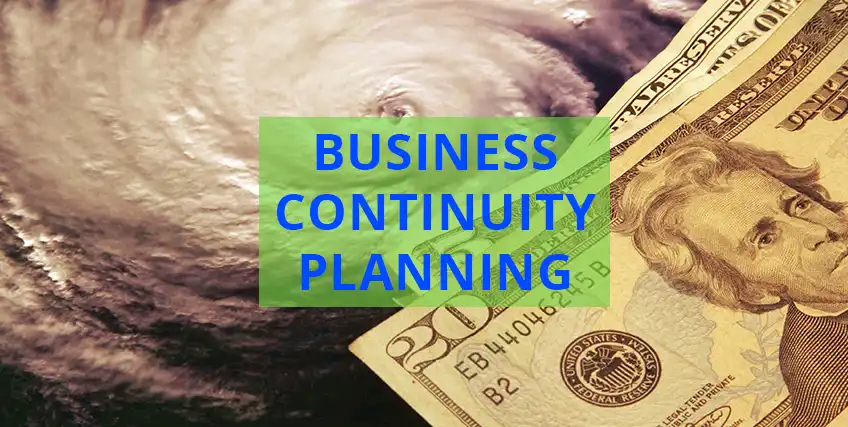7 Steps To Developing a Business Continuity Plan
March 13, 2025 | Last Updated on: March 13, 2025

What is a Business Continuity Plan and is it something you need for your business? Let’s face it: you don’t always know when a disaster is going to strike your business. There are some occasions such as natural disasters where you may get some advanced warning. But other crises such as power outages, cyber-attacks, theft, and fire are unpredictable and can severely impact business operations and cause a dramatic loss of revenue for your business.
Small businesses are particularly vulnerable when disasters occur. The US Small Business Association estimates that 25% of businesses don’t open again after a major disaster. The key to disaster management is planning. That’s where a good Business Continuity Plan comes into play. A Business Continuity Plan (BCP) is a proactive approach to protecting your business functions should some kind of disaster strike. It is a plan that outlines a strategy for your business to maintain essential functions until the crisis is resolved.
What is a business continuity plan?
A business continuity plan is a plan of action for your business to prepare for any type of catastrophic event: weather, flooding, fire, theft, outages, or cyber-attacks. This individualized plan is designed based on risk assessment and identification of critical business processes. A good BCP should be a comprehensive document that clearly outlines the plan for your business in the event of a disaster. It’s a good document to share with your business partners, other key stakeholders, or even show to lenders to help you secure financing.
To design your BCP you first need to take a look at your small business and identify the key components necessary for your individualized plan. The scope of your plan should include your business’s critical assets and plan for safety, communication with team members, IT, and potential alternate locations to conduct business. This scope is specific to your business and determined by you.
What are the steps involved in developing a BCP?
1. Identify the essential functions of the business.
The first step in any type of planning is assessment. Assessing your business is key to understanding what needs to be included in your BCP. Decide what are the time-sensitive or critical functions you need for your business to stay afloat. Then, identify what and who is needed to maintain these critical functions. Determine what safety measures are already in place within your business – these will be included in your BCP. Keep in mind; this evaluation should encompass the entire scope of your business.
2. Identify the most likely disasters that could affect your business.
You may live in an area that is prone to extreme weather events. Hurricanes and tornadoes cause tremendous physical damage to physical structures and equipment. These weather events have also left cities without power and/or internet services for extended periods. Flooding and fires can occur and cause terrible damage. Another destructive event would be a security breach. Breaches in security have resulted in the loss of revenue due to the loss of client’s trust and loyalty. Healthcare companies, in particular, have seen a dramatic increase in cyber attacks and ransomware attacks since 2017. Identify how security breaches or malware attacks could disrupt your business. Your BCP should outline the resources you’ll use to adapt your business flow if such an attack occurs.
3. Identify critical assets to your organization.
Critical assets encompass more than just physical property. They include equipment, intellectual property, employees, and inventory. Critical assets also extend to include customer information, suppliers, important paper documents, and data files. Evaluate your business and keep a checklist of these assets. Each of these needs to be covered by your BCP.
4. Identify safety equipment and procedures.
A strong business continuity plan covers safety equipment and procedures. Some companies enlist an employee or employees to become “safety officers” for the organization. These employees would be part of the planning and stay up to date on the safety procedures. Safety checklists are used by organizations because they are clear and concise. These checklists can be included in the BCP and should be easily accessible to employees if they are needed. Also, a safety plan must identify who to call and what procedure to follow in the event of any type of emergency.
5. Employee Management.
Employees are the most vital assets of your business. Managing employees effectively in times of crisis is essential. During the acute phase of the crisis, employee safety is the priority. Consider how to notify staff of emergencies and how safely evacuate employees if necessary. Long-term considerations for your BCP include potential scheduling changes, payroll delays, and the need for bringing in temporary staff if employees have difficulty accessing the site. This plan must be clear and easy to understand.
6. Critical information for disaster.
There are certain types of information that every small business should have easy access to, including insurance policies, customer contact information, and supplier contact information. A copy of these should be stored in the cloud or at an offsite location. Your BCP should identify the location of this data and how to access the information. Easy access to insurance records and policy information will aid in your recovery. Your BCP should identify types of insurance plans and coverage, policy numbers, and important contact information for each policy. Performing regular data backups on this information is also a vital step in creating an reliable and effective business continuity plan.
Other critical pieces of information are customer and supplier contact information. Being proactive and contacting your customers and suppliers as soon as possible will decrease inquiries and ease customer and supplier concerns. If you live in an area where weather events tend to occur, you may even want to review your BCP with your customers and suppliers before any events occur. This will give them valuable information to keep let them know that you have a plan in place and won’t be leaving them unserved.
7. Alternate business locations and outsourcing.
Depending on the type and severity of the disaster, you may need to consider a temporary alternative location for your business. This alternate location could house your whole business or your inventory and records. At the same time, if you cannot find an alternate location you may consider identifying companies you can temporarily outsource to meet your clients’ needs. A good partnership that’s ready for an emergency can be of great value to your business, even when times are good.
At the end of the day, preparing for the worst is the key to making a full recovery. Your Business Continuity Plan will help you know exactly what you have to do to get back to business after any kind of disaster. What’s even better is that it can help you qualify for disaster recovery loans when you need them most.
A Business Continuity Plan will take time and energy and it can be overwhelming to get started. But, before you throw up your hands and say forget it to the BCP, remember that even an imperfect plan is better than no plan. Take just a few minutes to look at your business and develop a plan that works for you. It doesn’t need to be overwhelming – make a plan that is clear and concise and includes the correct information for your business. And remember, Business Continuity Plans help mitigate financial losses by protecting your business, your property, and most importantly, your reputation.
Covid-19 had and is still having many effects on different small businesses. Check out our helpful guide on creating a small business continuity plan for the Covid-19 crisis.
Conclusion:
A well-prepared Business Continuity Plan protects your business from unexpected disruptions, natural disasters, cyber-attacks, or other crises. You can minimize financial losses and ensure a smooth recovery by identifying risks, safeguarding critical assets, and establishing clear procedures.
Having a solid plan in place not only helps you resume operations quickly but also reassures employees, customers, and stakeholders. Planning strengthens your business’s resilience, enhances preparedness, and secures long-term success in an unpredictable world.
FAQs
What are the steps of a business continuity plan?
Developing an effective business continuity plan involves four key steps. First, identify potential threats or risks that could disrupt operations, such as cyberattacks, natural disasters, or supply chain failures. Next, conduct a business impact analysis to assess how these risks could affect critical functions and determine the potential financial and operational consequences. Then, implement preventive measures and mitigation strategies to minimize disruptions and enhance resilience. Finally, the plan should be regularly tested, refined, and improved to remain effective and adaptable to evolving threats.
What are the 6 stages of the BCM lifecycle?
The business continuity lifecycle consists of six essential stages. It begins with an impact analysis, including a business impact analysis (BIA) and a risk assessment to identify potential threats and their consequences. Next is the design phase, where strategies and frameworks are developed to address identified risks. The implementation stage follows, putting the plan into action by establishing policies, procedures, and response mechanisms. Once in place, the plan undergoes testing to evaluate its effectiveness in real-world scenarios. Ongoing maintenance ensures that the plan remains up to date with changing business needs and emerging risks. Finally, continuous improvement refines the plan, incorporating lessons learned from testing and real incidents to enhance resilience.
What are the 4 P's of BCP?
The four P’s of business continuity are people, processes, premises, and providers, essential for operational resilience. People include employees, customers, and clients, who are crucial to running the business. Processes encompass the technology, workflows, and strategies that maintain efficiency and productivity. Premises refer to the physical locations where the business operates, ensuring they remain secure and functional during disruptions. Lastly, providers include suppliers and service partners whose reliability is vital for sustaining operations. A strong business continuity plan considers all four elements to minimize risks and ensure long-term stability.
What are the 7 main components of the business plan explain each one of them?
Most business plan templates include seven essential elements. It starts with an executive summary, giving a high-level overview of the business and its goals. The company description explains the business's mission, vision, and structure. The products and services section details what the business offers and how it benefits customers. A market analysis helps identify industry trends, competitors, and target audiences. The marketing strategy outlines how the business plans to attract and retain customers. The financials section covers revenue projections, funding needs, and profitability expectations. Finally, the budget ensures the smart allocation of resources for sustainable growth.
Which is the best business to start?
No one-size-fits-all answer to the best business to start depends on your skills, interests, and available resources. That said, some businesses are more profitable and accessible than others. Online businesses, such as e-commerce, digital marketing, or selling online courses, offer flexibility and scalability. Service-based businesses, like cleaning services, handyperson work, or personal training, can also be great options, especially if you have expertise in a particular trade. The key is to choose a business that aligns with your strengths and has strong market demand.




